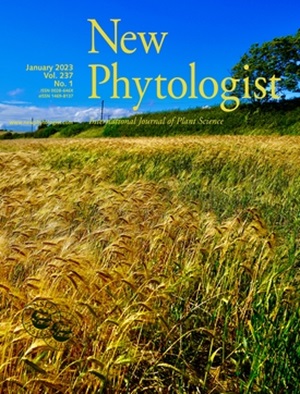GTE7-IES2B-GTE2复合体表观遗传调控拟南芥硫稳态。
IF 8.1
1区 生物学
Q1 PLANT SCIENCES
引用次数: 0
摘要
维持硫(S)稳态对植物生长发育至关重要,但调节硫酸盐吸收的机制仍然知之甚少。我们发现全球转录因子E组蛋白GTE7和GTE2,以及染色质重塑因子INO80亚基2B (IES2B)是拟南芥S稳态的关键调节因子。1. GTE7直接结合硫酸盐转运基因SULTR1启动子中的硫响应元件(SURE);在S状态下,SURE侧翼序列发生动态DNA甲基化,在S充足条件下发生超甲基化,在S缺乏条件下发生低甲基化。GTE7及其同源物GTE2在抑制硫酸盐在芽中的积累方面表现出功能冗余。gte7和gte2双突变体表现出硫酸盐在茎部积累增加和根系生长受损的现象。IES2B是INO80染色质重塑复合体的一个亚基,它与GTE7和GTE2相互作用,形成一个调节SULTR1启动子上动态DNA甲基化的调控复合体。IES2B的破坏消除了s再供给诱导的DNA再甲基化和硫酸盐积累的增加。我们的研究结果揭示了一个GTE7-IES2B-GTE2模块,它可能整合了转录调控和动态DNA甲基化来微调硫酸盐的内稳态,为了解S可用性响应的转录和表观遗传调控的复杂网络提供了见解。本文章由计算机程序翻译,如有差异,请以英文原文为准。
The GTE7-IES2B-GTE2 complex epigenetically regulates sulfur homeostasis in Arabidopsis thaliana.
Maintaining sulfur (S) homeostasis is critical for plant growth and development, yet mechanisms regulating sulfate uptake remain poorly understood. We identify Global Transcription Factor Group E proteins, GTE7 and GTE2, along with the chromatin remodeling factor INO80 Subunit 2B (IES2B), as key regulators of S homeostasis in Arabidopsis thaliana. GTE7 directly binds to the Sulfur Response Element (SURE) in the promoter of the sulfate transporter gene SULTR1;1. The SURE flanking sequence undergoes dynamic DNA methylation in response to S status, with hypermethylation under S-sufficient conditions and hypomethylation under S-deficient conditions. GTE7 and its homolog GTE2 exhibit functional redundancy in suppressing sulfate accumulation in shoots. The gte7 gte2 double mutants displayed increased sulfate accumulation in shoots and impaired root growth. IES2B, a subunit of the INO80 chromatin remodeling complex, interacts with both GTE7 and GTE2, forming a regulatory complex that modulates dynamic DNA methylation at the SULTR1;1 promoter. Disruption of IES2B abolished S-resupply-induced DNA remethylation and elevated sulfate accumulation in shoots. Our findings reveal a GTE7-IES2B-GTE2 module that likely integrates transcriptional regulation and dynamic DNA methylation to fine-tune sulfate homeostasis, providing insights into the complex network of transcriptional and epigenetic regulation in response to S availability.
求助全文
通过发布文献求助,成功后即可免费获取论文全文。
去求助
来源期刊

New Phytologist
生物-植物科学
自引率
5.30%
发文量
728
期刊介绍:
New Phytologist is an international electronic journal published 24 times a year. It is owned by the New Phytologist Foundation, a non-profit-making charitable organization dedicated to promoting plant science. The journal publishes excellent, novel, rigorous, and timely research and scholarship in plant science and its applications. The articles cover topics in five sections: Physiology & Development, Environment, Interaction, Evolution, and Transformative Plant Biotechnology. These sections encompass intracellular processes, global environmental change, and encourage cross-disciplinary approaches. The journal recognizes the use of techniques from molecular and cell biology, functional genomics, modeling, and system-based approaches in plant science. Abstracting and Indexing Information for New Phytologist includes Academic Search, AgBiotech News & Information, Agroforestry Abstracts, Biochemistry & Biophysics Citation Index, Botanical Pesticides, CAB Abstracts®, Environment Index, Global Health, and Plant Breeding Abstracts, and others.
 求助内容:
求助内容: 应助结果提醒方式:
应助结果提醒方式:


